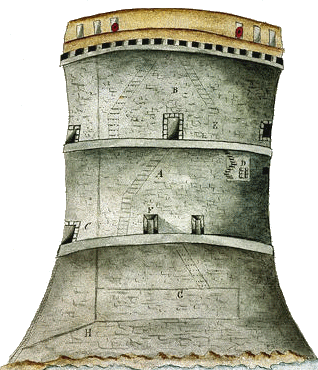Martello Towers in the UK

A chain of towers based on the original Mortella tower were built to defend the south and east coast of England, to guard against possible invasion from France, then under the rule of Emperor Napoleon.
A total of 103 Martello towers were built in England, set at regular intervals along the coast from Seaford, Sussex, to Aldeburgh, Suffolk. Most were constructed under the direction of General William Twiss (1745–1827) and a Captain Ford. The northern-most tower at Aldeburgh is of quatrefoil design, i.e. four in one.
Included in the scheme were three much larger circular forts or redoubts that were constructed at Harwich, Dymchurch and Eastbourne; they acted as supply depots for the smaller towers as well as being powerful fortifications in their own right.
The effectiveness of Britain's Martello towers was never actually tested in combat against a Napoleonic invasion fleet. They were, however, effective in hindering smuggling. After the threat had passed, the Martello towers in England met a variety of fates. The Coastguard took over many to aid in the fight against smuggling.
Fifteen towers were demolished to enable the re-use of their masonry. The sea washed thirty away and the military destroyed four in experiments to test the effectiveness of the new rifled artillery. During the Second World War, some Martello towers returned to military service as observation platforms and firing platforms for anti-aircraft artillery.
Forty-seven Martello towers have survived in England, a few of which have been restored and transformed into museums, visitor centres, and galleries. Some are privately owned or are private residences, The remainder are derelict. A survey of the East Coast towers in 2007 found of the 17 remaining, most were in a reasonable condition.
![]() Find out about Martello Towers in Suffolk
Find out about Martello Towers in Suffolk
![]() Find out about Martello Towers in Essex
Find out about Martello Towers in Essex
![]() Find out about Martello Towers in Kent
Find out about Martello Towers in Kent
![]() Find out about Martello Towers in Sussex
Find out about Martello Towers in Sussex

Three Martello towers were built in Scotland, the first on offshore rocks facing the Firth of Forth in 1807–09 to defend Leith Harbour. The Tally Toor now lies land-locked within the eastern breakwater.
Two towers were then built at Hackness and Crockness, near Longhope in Orkney. They were constructed between 1813 and 1815 to guard against the threat of French and American raiders attacking convoys assembling offshore. Historic Scotland now operates the Hackness tower as a museum.

A small number of Martello towers were also built in Wales, of which few survive. The most notable surviving towers are the two located in Pembroke Dock, which were built between 1848 and 1857 to protect the naval base there. Today, one of the towers is privately owned. The other is located on the town's riverfront, next to the old entrance of the naval base. It has been converted into a small museum that focuses on the local history of the dock and its defences.[




 Red Dragon I.T. Ltd.
Red Dragon I.T. Ltd.